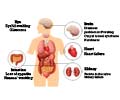Research into both the cause and treatment of Alzheimer's disease is looking into the deposition of amyloid beta in the brains of individuals suffering from the condition.

Other proteins are often co-deposited in vivo with amyloid beta and one such protein is serum amyloid P component (or SAP). Recent evidence has suggested that SAP is elevated in Alzheimer's disease and a team of researchers from Keele University in Staffordshire, UK, led by Professor Chris Exley, has shown that physiologically-significant concentrations of SAP promote the deposition of amyloid beta under conditions approaching those found in vivo.
"We have shown that SAP is bound by fibrils of amyloid beta and that this interaction stabilises the fibrils over timescales which are physiologically significant," said Exley.
"This is the first example of a physiologically significant biomolecule promoting and stabilising the formation of amyloid fibrils of amyloid beta 42 under near-physiological conditions," he added.
The group also found that this property of SAP was enhanced in the presence of aluminium, a metal which has also been shown to be co-deposited with amyloid beta in Alzheimer's disease.
There have been recent efforts to reduce the plasma concentration of SAP as a therapy for Alzheimer's disease and the research provides strong evidence that SAP is involved in the deposition of amyloid beta 42 in Alzheimer's disease and that by reducing the plasma concentration of SAP it might also reduce the deposition of amyloid beta.
Advertisement
Source-ANI











